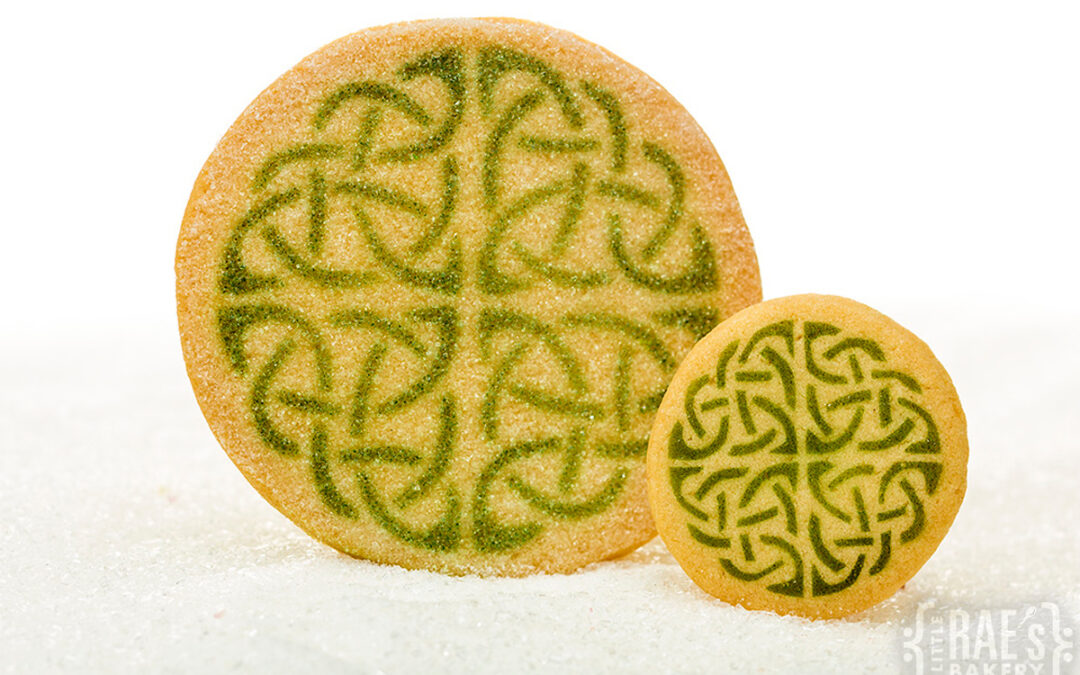With St. Patrick’s Day fast approaching, millions of Americans are dusting off that Irish heritage and getting excited about things like shamrocks, the color green, and Irish culture. We’re fans of celebrating your cultural heritage, but we think it’s way cooler to celebrate and learn about that heritage.
Each year around this time, we have a few special shortbread cookie designs – our Lucky Clovers and our Celtic Knots / Celtic Drops. While last year, we learned about the difference between shamrocks and clovers, this year we’re taking a dive into the history of Celtic knots: when they came into (and went out of) vogue, the main types of Celtic knots, and what the basic Celtic knots symbolize.
Sit back, grab a pack of our shortbread cookies, and read on!
Celtic Knot History 101
According to most historians, interlaced knot patterns first started making appearances around the 3rd and 4th centuries C.E. and can be found in many cultures around the world—they are not proprietary to the Celts. Since our focus today is specifically on Celtic knots, we won’t go into depth about occurrences in other cultures except to mention a few specific knots and patterns that cross cultural lines.
In Celtic culture, there are two eras that define knot and interlace patterns—pre-Christianity and post-Christianity. Spirals, step patterns, and key patterns are some of the earliest and most dominant pre-Christianity motifs. In the 3rd and 4th century, interlace patterns—looping, braiding, and knotting—rose in popularity as well.
Once Christianity spread across the isles, Celtic and Anglo-Saxon traditions merged to form the insular art that is most recognizably “Celtic” today. Perhaps one of the best early historical records we have of this is in the famous Book of Kells, printed in the 9th century C.E.
In England, the Viking invasions of the 9th century C.E. are considered to have concluded the insular art period. In Ireland, the tradition continued a while longer, until around the 12th century. Today, Celtic knots continue to be a recognizable and important part of visual history throughout Ireland and for those of Irish-American heritage.
Major Celtic Knot Pattern Types
In general, Celtic knots are believed to symbolize the interconnectedness of life and eternity, though specific types of patterns and knots do have unique meanings in addition to that. Here are the major pattern types:
- Knotwork interlace – This Celtic patten type includes knots like the trinity knot and the lover’s knot. It represents the interconnectedness of life and our place within the universe.
- Celtic spirals – This is one of the oldest Celtic patterns, predating Christian influence. It is believed to symbolize eternal life. A common design features three connected spirals, thought to represent the heavens, the cosmos, and water. In ancient Celtic culture, a single spiral was representative of the sun while a double spiral represented the equinox.
- Step patterns – These patterns represent development and progression, and perhaps even the connection between heaven and earth. This type of pattern is not unique to Celtic culture; it can also be found in Ancient Mayan, Egyptian, and Aztec civilizations.
- Basic knots – There are eight “basic” knot patterns made of 3- or 4-cord plaits. These include the Trinity knot, Celtic love knot, Celtic cross, Celtic spiral knot, Celtic shield knot, Dara knot, Solomon’s knot, and Celtic sailor’s knot. Each has a unique meaning (which we explore below).
While there are many variations and aesthetic interpretations of Celtic knots (some ancient and some modern), these are eight types of basic knots.

- Trinity knot, triquetra, trefoil knot, or triskele – This knot of many names is one of the best-known designs. Made of 3 arcs, this knot is commonly believed to represent the Holy Trinity. Three is also a sacred number in Celtic mythology, and other interpretations of the three arcs include life, death, and rebirth; the earth, sky, and sea; and the past, present, and future.
- Love knot – Featuring two interlocking hearts, it is believed that lovers exchanged this pattern as a symbol of affection—not unlike our modern exchange of rings.
- Sailor’s knot – This knot is said to have been crafted by sailors to remind them of loved ones back home. It represents friendship, affection, love, and harmony. While it is one of the simplest knots, it is also one of the strongest.
- Shield knot – Variations of this four-cornered knot can be found in cultures across the world. In Celtic tradition, the shield knot is used for protection from spirits or even opposing armies. It was used commonly by warriors, children, and the ill.
- Solomon’s knot – This knot is four-cornered and features two endless loops woven together. It is featured in Roman mosaics as well as in early synagogues. In Yoruba, it is used in textiles and carvings as symbol of royal status. In Jewish culture, Solomon’s knot is a symbol of eternity. For the Celts, it represents infinite love and faith.
- Dara knot or the eternity knot – This knot is actually not a traditional knot, but it is popular in modern times. Drawing inspiration from infinity knots and the roots of oak trees, this knot symbolizes grounding and strength.
- Celtic spiral knot – One of the earliest designs, the spiral knot represents eternal life, oneness, and the spirit of unity. It features three spirals connected by a single, continuous line. A more Pagan interpretation is that the three spirals represent water, fire, and earth.
- Celtic cross – Another of the most recognizable knots is the Celtic cross. Unsurprisingly, this knot symbolizes culture and faith. Traditional Celtic cross designs feature a circular nimbus around where the horizontal and vertical beams of the cross meet. The Celtic cross represents strength, knowledge, and compassion. Its four beams may represent the four elements or perhaps our mind, soul, body, and heart. The central circle represents eternal love.
Using the above as a reference, which type of knot do you think our Celtic Knot and Celtic Drop shortbread cookies use? Drop your guess in the comments below!
Like this piece? Check out our previous blog on the history of shortbread!

